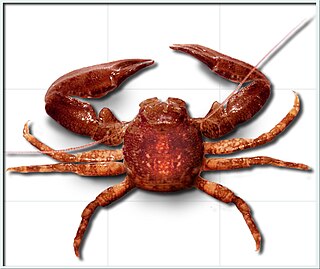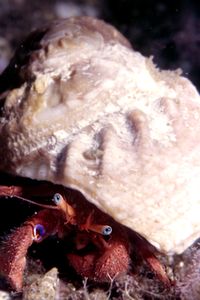
Libinia emarginata, the portly spider crab, common spider crab or nine-spined spider crab, is a species of stenohaline crab that lives on the Atlantic coast of North America.

The Japanese spider crab is a species of marine crab and is the biggest one that lives in the waters around Japan. At around 3.7 meters, it has the largest leg-span of any arthropod. The Japanese name for this species is taka-ashi-gani,, literally translating to “tall legs crab”. It goes through three main larval stages along with a prezoeal stage to grow to its great size.

Stenorhynchus seticornis, the yellowline arrow crab or simply arrow crab, is a species of marine crab.

Notomithrax ursus, known as the hairy seaweed crab, is a spider crab of the family Majidae.

Latreilliidae is a small family of crabs. They are relatively small, long-legged crabs found on soft bottoms at depths of up 700 metres (2,300 ft) in mostly tropical and subtemperate waters around the world. Their carapace is very small and doesn’t cover the bases of their legs, which protrude from the cephalothorax in a spider-like manner. The family and its type genus are named after Pierre André Latreille. The oldest known fossils from the Latreillidae have been dated to the middle of the Cretaceous period. It comprises seven extant species.

Crustaceans may pass through a number of larval and immature stages between hatching from their eggs and reaching their adult form. Each of the stages is separated by a moult, in which the hard exoskeleton is shed to allow the animal to grow. The larvae of crustaceans often bear little resemblance to the adult, and there are still cases where it is not known what larvae will grow into what adults. This is especially true of crustaceans which live as benthic adults, more-so than where the larvae are planktonic, and thereby easily caught.

Pisidia longicornis, the long-clawed porcelain crab, is a species of porcelain crab that lives in the north-eastern Atlantic Ocean. It varies from reddish to white, and grows to a carapace width of 1 cm (0.4 in). It was first named by Carl Linnaeus in 1767, although the etymology remains unclear.

Inachus phalangium, Leach's spider crab, is a species of crabs from the north-eastern Atlantic Ocean and Mediterranean Sea. It is up to 20.5 mm (0.81 in) wide, and is very similar to other species in the genus Inachus.

Oregonia gracilis, commonly known as the graceful decorator crab, is a species of crab belonging to the family Oregoniidae. Like other decorator crabs it habitually attaches other organisms to its back. The sessile organisms are attached to hooked setae that act as a sort of velcro attachment. This decoration provides visual and chemical camouflage thus reducing predation risk. Pacific halibut are a major predator of O. gracilis. Other predators include octopus and sea otters. The main food source of O. gracilis is floating kelp and algae that they capture utilizing a waiting strategy in order to maintain cryptosis.

Pisa armata is a species of crab from the eastern Atlantic Ocean.

Libinia dubia, the longnose spider crab, is a species of crab in the family Epialtidae. It is found in shallow waters on the eastern coast of North America.

Lychnorhiza lucerna is a species of jellyfish in the order Rhizostomeae. It is found off the Atlantic coasts of South America.

Hemicaranx amblyrhynchus is a tropical marine fish in the jack family (Carangidae). It is found in shallow parts of the western Atlantic Ocean.

Loxorhynchus grandis, commonly known as the sheep crab or spider crab, is a species of crab in the family Epialtidae. It is the largest crab found on the California coast. The species was first described to science by William Stimpson in 1857. The type specimen was collected on the coast of California, near San Francisco. Fossils from the late Miocene epoch indicate that this species is at least 11.63 to 5.333 million years old.

Pyromaia tuberculata is a species of crab in the family Inachoididae.
Mithraculus cinctimanus is a species of crab in the family Majidae. It is found in the Caribbean region and is usually associated with a sea anemone, sponge or coral.

Cyclocoeloma is a genus of crabs in the family Majidae, containing the single species Cyclocoeloma tuberculata.

Latreillia elegans is a species of crab belonging to the family Latreilliidae. This family of crabs is identified by their appearance as small, long-legged crabs. The species belongs to the genus Latreillia which has only five identified species: L. elegans, L. metanesa, L. williamsi, L.valida, and L. pennifera. It was previously thought that L. elegans and L. mannengi were two separate species, but it has since been revealed that the two species are synonymous. All the thought to be differences between L. elegans and L. mannengi were in actuality overlaps. The L. mannengi is simply referring to the close relative to the species of L. elegans found in the western Atlantic.

Paguristes eremita, the eye spot hermit crab, is a species of hermit crab in the family Diogenidae. It is found in the Mediterranean Sea.

Libinia spinosa is a majoid crab found in mud and sand bottoms of the Southwestern Atlantic and Pacific oceans. It is a generalist feeder on organisms such as algae, sponges, cnidarians, mollusks, polychaetes, crustaceans, and small fish. It commonly engages in a symbiotic relationship with the medusa Lychnorhiza lucerna.


















